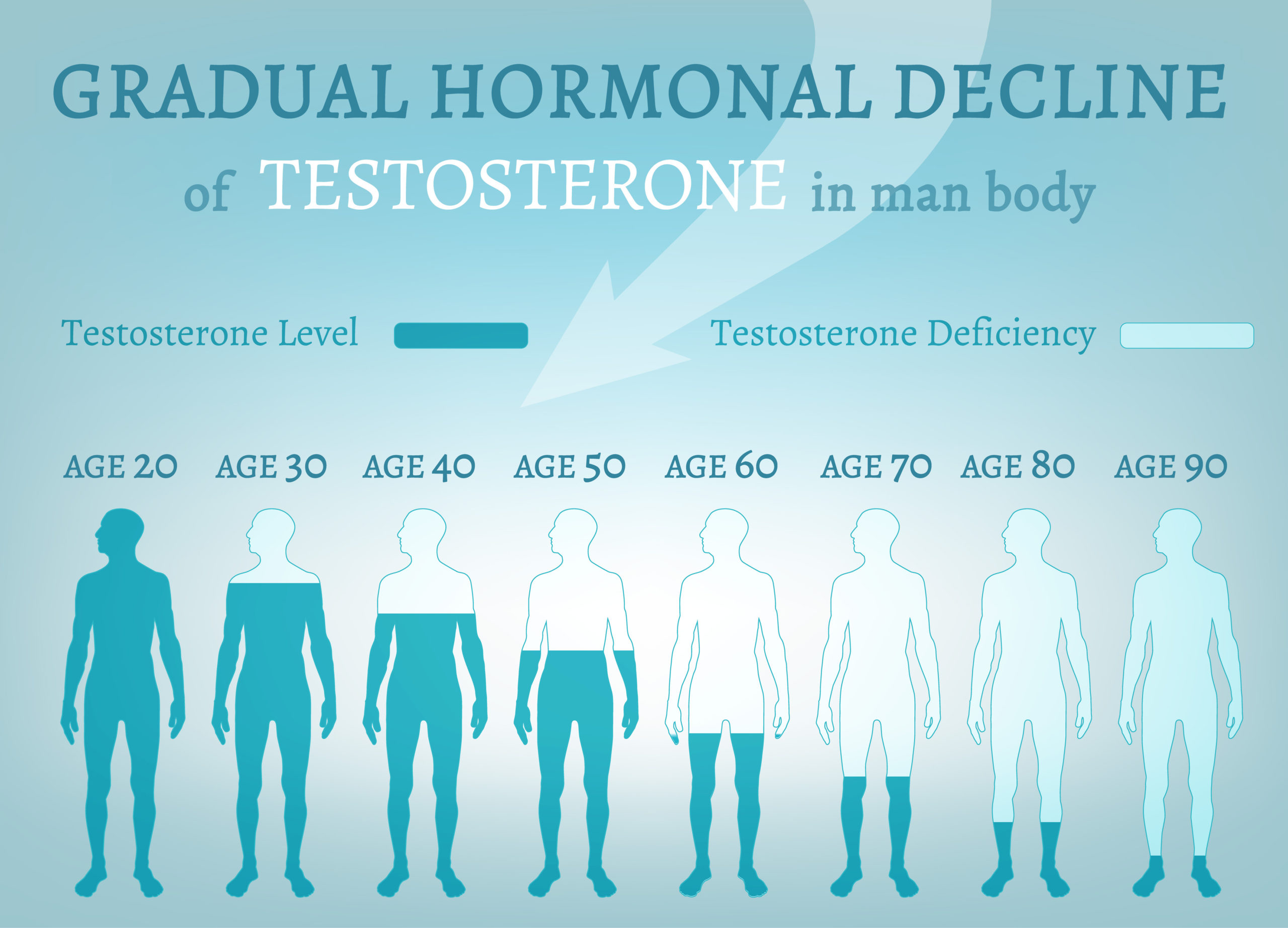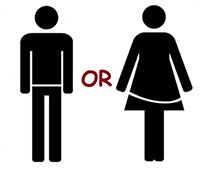We offer evidence-based and effective treatment of men with symptoms of low testosterone, with focus on the cause, restoration of natural production, prevention, holistic education, and effective supplementation. We believe that every man with symptoms of low testosterone requires a personalized approach and treatment as indicated.

Men – Lost Your Juice?
By Kambiz Tajkarimi, MD
Urology Surgical Consulting, PC
Do you wake up every morning dragging your feet out of bed? Feeling fatigued, have low desire for sex, cloudy mental sharpness? Have a large band of fat around your waste? You feel that your muscles left your body a decade ago? Have your lost your juice? You may have low testosterone.
What is low testosterone?
Low testosterone (male hypogonadism) is a condition in which the testes (testicles, the male reproductive glands) do not produce enough testosterone (a male sex hormone). Low testosterone affects almost 40% of men aged 45 and older. There is difficulty defining normal testosterone levels, because levels vary throughout the day and are affected by your body mass index, alcohol, nutrition, certain medications, age and illness.
As a man ages, testosterone gradually drops. This natural decline starts after age 30 and continues (about 1% per year) throughout his life.

Low testosterone numbers do not necessarily indicate need for therapy if you don't have symptoms of low T. Many cases show normal numbers with symptoms and therapy can give improvement.
What are the benefits of testosterone replacement therapy?
Potential benefits of testosterone replacement therapy may include:
· Loss of fat
· Increased bone density and protection against osteoporosis
· Improved mood and sense of well-being
· Improved sexual function
· Improved mental sharpness
· Greater muscle strength and physical performance
How is low testosterone diagnosed?
Low testosterone is diagnosed by measuring the amount of testosterone in the blood with a blood test. The levels may vary and repeat testing is often performed. The highest levels of testosterone are generally in the morning, near 8 a.m.
How is low testosterone treated?
Using testosterone replacement therapy, treatment is done in several different ways:
· Intramuscular injections (into a muscle), usually every 10 to 14 days
· Testosterone patches, which are used every day and are applied to different parts of the body
· Testosterone gels that are applied every day to the skin of the upper back and arms
· Pellets that are implanted under the skin every 3-4 months
Are there side effects?
The side effects of testosterone replacement therapy include: (symptoms are uncommon)
· Acne or oily skin
· Swelling in the ankles caused by mild fluid retention
· Stimulation of the prostate (can cause difficulty urinating)
· Breast enlargement/tenderness
· Worsening of sleep apnea
· Smaller testicles
· Skin irritation (in patients receiving topical testosterone replacement)
Good nutrition, exercise, weight management and avoiding excessive alcohol or drug use helps keep testosterone levels normal. An experienced physician must perform testosterone replacement therapy and monitoring with meticulous follow up to find your sweet spot testosterone level with minimal side effects.
Meticulous follow up is necessary for optimal results and prevention of side effects and other related diseases, such as prostate cancer.


 Low testosterone numbers do not necessarily indicate need for therapy if you don't have symptoms of low T. Many cases show normal numbers with symptoms and therapy can give improvement.
What are the benefits of testosterone replacement therapy?
Potential benefits of testosterone replacement therapy may include:
· Loss of fat
· Increased bone density and protection against osteoporosis
· Improved mood and sense of well-being
· Improved sexual function
· Improved mental sharpness
· Greater muscle strength and physical performance
How is low testosterone diagnosed?
Low testosterone is diagnosed by measuring the amount of testosterone in the blood with a blood test. The levels may vary and repeat testing is often performed. The highest levels of testosterone are generally in the morning, near 8 a.m.
How is low testosterone treated?
Using testosterone replacement therapy, treatment is done in several different ways:
· Intramuscular injections (into a muscle), usually every 10 to 14 days
· Testosterone patches, which are used every day and are applied to different parts of the body
· Testosterone gels that are applied every day to the skin of the upper back and arms
· Pellets that are implanted under the skin every 3-4 months
Are there side effects?
The side effects of testosterone replacement therapy include: (symptoms are uncommon)
· Acne or oily skin
· Swelling in the ankles caused by mild fluid retention
· Stimulation of the prostate (can cause difficulty urinating)
· Breast enlargement/tenderness
· Worsening of sleep apnea
· Smaller testicles
· Skin irritation (in patients receiving topical testosterone replacement)
Good nutrition, exercise, weight management and avoiding excessive alcohol or drug use helps keep testosterone levels normal. An experienced physician must perform testosterone replacement therapy and monitoring with meticulous follow up to find your sweet spot testosterone level with minimal side effects.
Meticulous follow up is necessary for optimal results and prevention of side effects and other related diseases, such as prostate cancer.
Low testosterone numbers do not necessarily indicate need for therapy if you don't have symptoms of low T. Many cases show normal numbers with symptoms and therapy can give improvement.
What are the benefits of testosterone replacement therapy?
Potential benefits of testosterone replacement therapy may include:
· Loss of fat
· Increased bone density and protection against osteoporosis
· Improved mood and sense of well-being
· Improved sexual function
· Improved mental sharpness
· Greater muscle strength and physical performance
How is low testosterone diagnosed?
Low testosterone is diagnosed by measuring the amount of testosterone in the blood with a blood test. The levels may vary and repeat testing is often performed. The highest levels of testosterone are generally in the morning, near 8 a.m.
How is low testosterone treated?
Using testosterone replacement therapy, treatment is done in several different ways:
· Intramuscular injections (into a muscle), usually every 10 to 14 days
· Testosterone patches, which are used every day and are applied to different parts of the body
· Testosterone gels that are applied every day to the skin of the upper back and arms
· Pellets that are implanted under the skin every 3-4 months
Are there side effects?
The side effects of testosterone replacement therapy include: (symptoms are uncommon)
· Acne or oily skin
· Swelling in the ankles caused by mild fluid retention
· Stimulation of the prostate (can cause difficulty urinating)
· Breast enlargement/tenderness
· Worsening of sleep apnea
· Smaller testicles
· Skin irritation (in patients receiving topical testosterone replacement)
Good nutrition, exercise, weight management and avoiding excessive alcohol or drug use helps keep testosterone levels normal. An experienced physician must perform testosterone replacement therapy and monitoring with meticulous follow up to find your sweet spot testosterone level with minimal side effects.
Meticulous follow up is necessary for optimal results and prevention of side effects and other related diseases, such as prostate cancer.

 As with any other medical treatment, the individual must be evaluated by a physician that is specialized or has extensive experience in the field of hormone rejuvenation or optimization therapies.
Your physician must include a detailed conversation with you regarding your symptoms and medical history. Furthermore, a detailed hormone examination ( blood, saliva or urine sample) through a laboratory equipped with appropriate processing and reporting of hormone levels along with metabolites of different hormones.
After reviewing a detailed hormone panel, your physician must sit down with you and discuss all your options about different types of therapy and make a personalized plan suited for you and your lifestyle.
What is the process associated with getting pellets inserted?
Once it is established by you and your physician that you will utilize the pellets as a part of your hormone optimization and rejuvenation therapy:
As with any other medical treatment, the individual must be evaluated by a physician that is specialized or has extensive experience in the field of hormone rejuvenation or optimization therapies.
Your physician must include a detailed conversation with you regarding your symptoms and medical history. Furthermore, a detailed hormone examination ( blood, saliva or urine sample) through a laboratory equipped with appropriate processing and reporting of hormone levels along with metabolites of different hormones.
After reviewing a detailed hormone panel, your physician must sit down with you and discuss all your options about different types of therapy and make a personalized plan suited for you and your lifestyle.
What is the process associated with getting pellets inserted?
Once it is established by you and your physician that you will utilize the pellets as a part of your hormone optimization and rejuvenation therapy:




